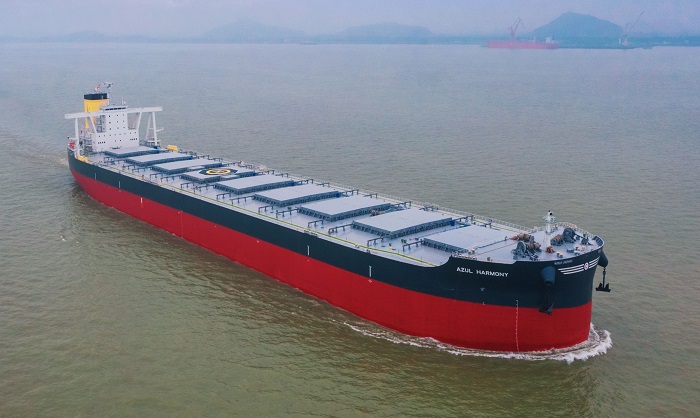Bulk Carrier AZUL HARMONY Delivered
Jun. 01, 2020

Tokyo, June 1, 2020 — Kawasaki Heavy Industries, Ltd. announced today that it delivered the bulk carrier AZUL HARMONY, with a capacity of 208,000 DWT (Kawasaki hull No. 8051, NACKS hull No. NE298), for Kumiai Navigation (Pte) Ltd at Nantong COSCO KHI Ship Engineering Co., Ltd. (NACKS), which is located in Nantong City, China and operated jointly with China COSCO Shipping Corporation Limited (China COSCO Shipping).
Delivery, principal particulars, and features of the vessel are as described below.
| Delivery | June 1,2020 |
|---|
| Principal Particulars | |
|---|---|
| Length overall | 299.99 m |
| Length between perpendiculars | 295.50 m |
| Molded breadth | 50.00 m |
| Molded depth | 25.00 m |
| Molded draft | 18.40 m |
| Gross tonnage | 108,020 t |
| Deadweight | 208,910 t |
| Hold capacity | 227,313 m3 |
| Main engine | One set of MAN B&W 6G70ME-C9.2 diesel engine Maximum continuous output: 15,250 kW at 66 rpm |
| Speed | Approx. 14.7 knots |
| Complement | 28 people |
| Classification | Nippon Kaiji Kyokai (ClassNK) |
| Country of registration | Shingapore |
Features
- The vessel employs various technologies to achieve maximum fuel economy, including an energy-saving, electronically-controlled main diesel engine, high propulsive efficiency propellers, and the Kawasaki Rudder Bulb System with Fins (RBS-F) and Semi-Duct System with contra Fins (SDS-F), which all contribute to the vessel’s enhanced propulsion performance.
- In order to satisfy new restrictions on SOx emissions*1 which is implemented by the International Maritime Organization (IMO) in this year, the vessel includes a set of SOx scrubber*2 at the exhaust gas outlets of the main engine and the power generation engine. With this system, general fuel oil can be used continuously after the regulations are tightened.
- The vessel incorporates various energy saving technologies, which reduce both fuel consumption and emission of carbon dioxide (CO2), thereby complying with the EEDI*3 Phase 2 requirements.
| *1 | SOx emission control: Currently, SOx emission restrictions in North American and European emission control areas (ECAs) limit sulfur content in fuels to 0.1% or less. Starting on January 1, 2020, new regulations will require that ships operating in all other parts of the world achieve fuel sulfur content levels of 0.5% or less, or alternatively, use equipment to reduce SOx in exhaust gases to an equivalent level. |
| *2 | SOx scrubber: an exhaust gas cleaning system, which removes SOx (sulfur oxide). |
| *3 | EEDI:Energy Efficiency Design Index . Compulsory international regulations requiring energy-efficiency compliance in newly built ships based on EEDI values, which specify CO2 emissions in grams for transporting one ton of cargo for one mile. EEDI regulation values apply in increasingly strict phases based on the construction-contract conclusion date and finished-ship delivery date. By Phase 2, bulk carriers are required to achieve a 20% reduction in CO2 emissions. |
Contact
If you need more information about our business,
please feel free to contact us.





